Street Hockey Rules Explained
If you’re new to street hockey, you’re probably wondering how exactly the game is played. We often receive questions like, is there icing? And how many players are on a team?
We’ve outlined the basic rules of street hockey to help you gain a better understanding of how to play.
Game Play
Street hockey is played—well, on the street. Players are on foot and use a ball instead of a puck. The size of the rink depends on the age and team size, but generally, street hockey rinks are smaller than ice hockey rinks.
While the objective is simple—to shoot the ball in the opponent’s net—it’s not as easy as it sounds. Every game starts with a face-off where opposing players face each other with their sticks one foot apart on the ground. When the referee drops the ball, the play begins. Games consist of two 15-minute halves with a running clock.
Positions
NHL STREET hockey teams play four on four with goalies. Typically, each team has two forwards and two defenders. The forwards take the most face-offs and try to score. The defensive players, on the other hand, remain behind the forwards and try to prevent the ball from getting past their goalie, who’s tasked with defending the goal.
Infractions
The referee will stop the clock whenever there is an infraction during game play, resulting in a change of possession. Here are the most common infractions in street hockey:
- Out of bounds: When the ball goes over the boards and out of play, the team that last touched the ball loses possession. And the non-offending team gains possession of the ball at the point where it went out of play, without a faceoff.
- Offsides: This occurs when a player enters their teams’ offensive zone prior to the ball entering the offensive zone, with the center court line serving as the divider. On an offsides play, the non-offending team gains possession of the ball, just beyond center court in their offensive zone.
- Hand pass: When you use your hand to bat, swat or throw the ball to your teammate.
Note: There isn’t icing in street hockey.
Penalties
Street hockey rules are designed to keep players safe, so penalties are taken very seriously. In NHL STREET, all penalties result in a penalty shot for the non-offending team and severe penalties result in players being ejected from the game.
Here’s a list of penalties that result in a penalty shot:
- High sticking, meaning anytime a stick comes above a player’s knee
- Abuse of officials, such as verbal abuse toward and/or physical contact with any official, both on and off court.
- Checking
- Cross-Checking
- Slashing
- Hooking
- Tripping
- Holding
- Interference
- Too many players on the court
If you’re interested in seeing the complete set of rules, you can download the NHL STREET Hockey rulebook.






